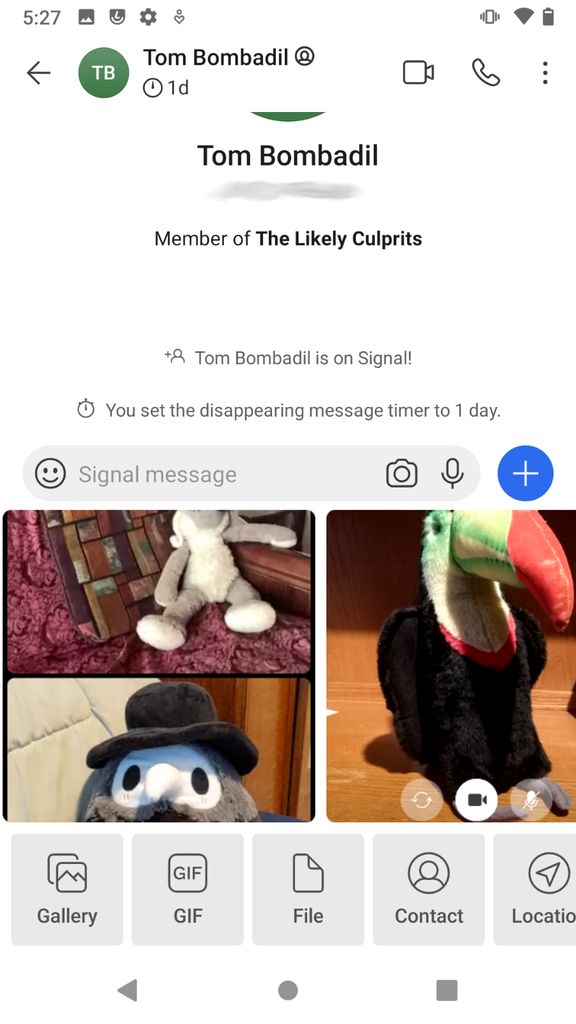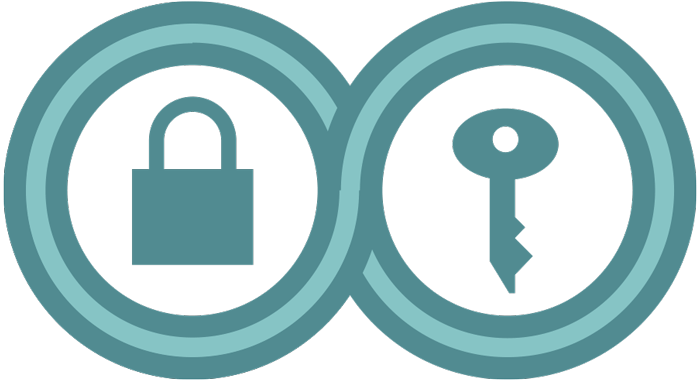How to: Use Signal for Android
We've updated this guide to a new page. Please see the new version here.
Signal is a free and open source software application for Android, iOS, and Desktop that employs end-to-end encryption to keep communications safe. Communications can be made between either individuals or a group, allowing users to send end-to-end encrypted text, picture, and audio & video messages, as well as engage in live video and audio calls. All users must have the Signal app installed to communicate with each other. Encrypted calls and messages use your data connection; therefore both parties to the conversation must have Internet access on their mobile devices. Due to this, Signal users don't incur SMS and MMS fees for encrypted communications. On Android, Signal can replace your default text messaging application, so within Signal it is still possible to send unencrypted SMS messages. Unencrypted SMS messages go through your mobile plan and may incur fees as set by your plan.
Download Location: The app can be downloaded from the Google Play store
System requirements: Android 4.4 and up
Version used in this guide: Signal Android 5.4.7
License: GPLv3
Other reading:
Level: Beginner-Intermediate
Time required: 15-20 minutes
Installing Signal on your Android Phone
Step 1: Download and Install Signal
On your Android device, enter the Google Play Store and search for “Signal.” Find Signal Private Messenger and tap “Install.”
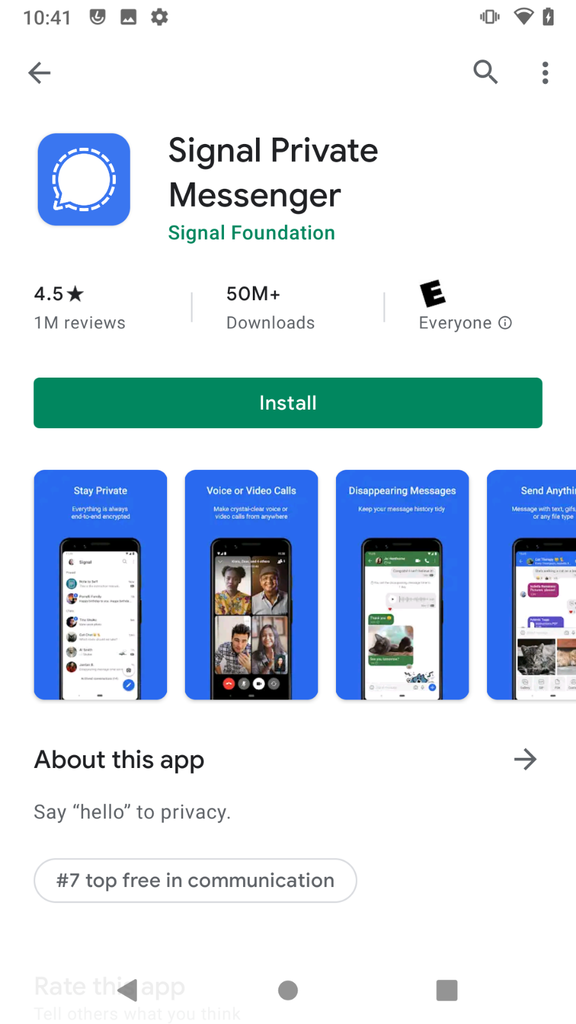
After Signal has finished installing, tap “Open” to launch the app.
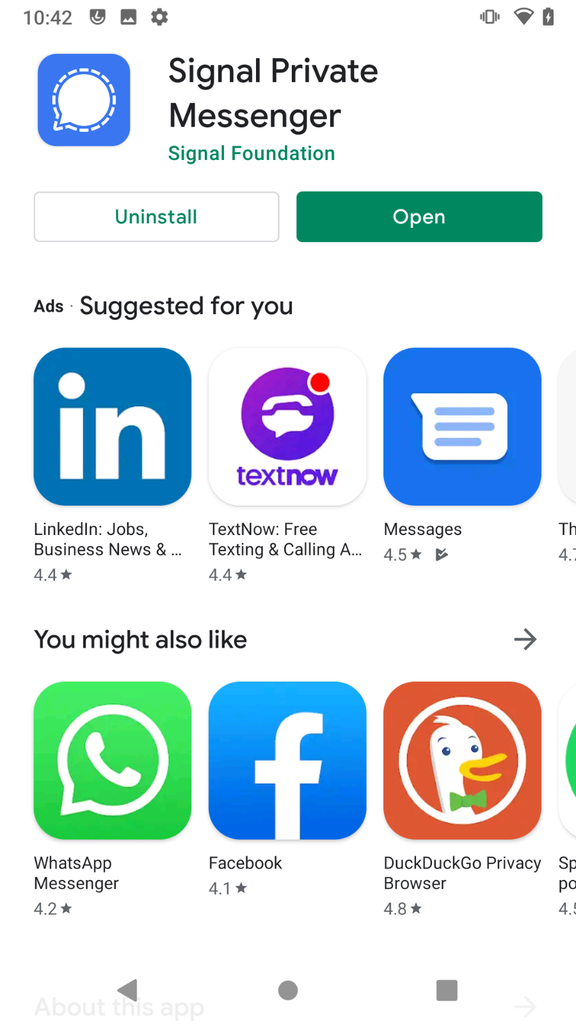
Step 2: Grant or Deny Permissions
After an introductory screen, you will see a dialogue explaining why Signal requests the “Contacts” permission on your phone.
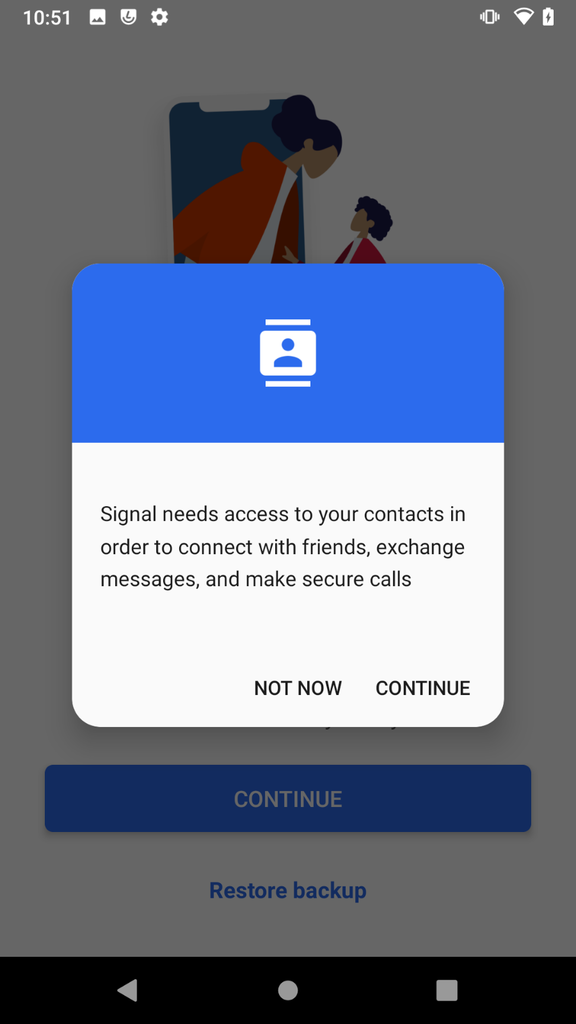
After tapping “Continue,” your Android phone will prompt you to share your contact list with the Signal app. This will allow you to more easily discover which of your contacts you can communicate with over Signal. If you don’t allow this permission, you can still use Signal, but you will have to manually enter your contact’s phone number to begin chatting with them.
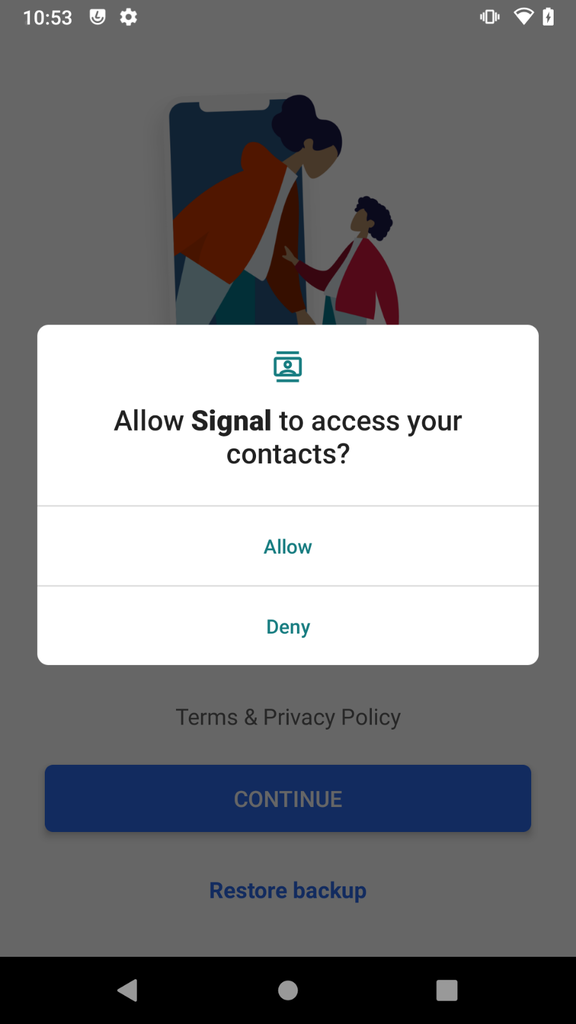
You will also be prompted to allow Signal to make and manage phone calls. If you don’t allow this permission, you can still use Signal, but Signal will have no way to know if you are currently on a call. As a result, any incoming Signal call may interrupt your regular phone calls.
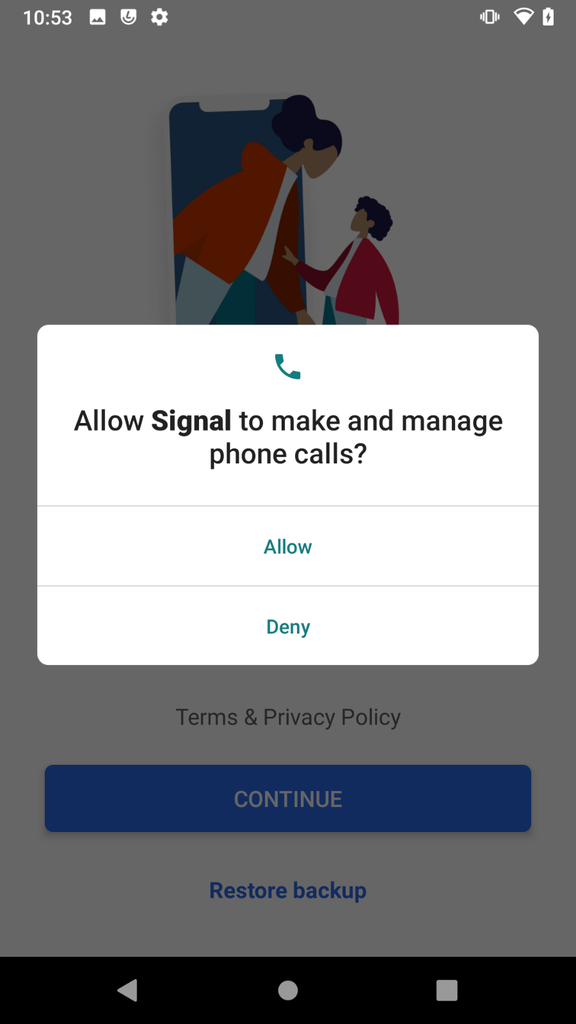
Step 3: Register and Verify your Phone Number
You will now see the following screen. Enter your mobile phone number and tap “Next.”
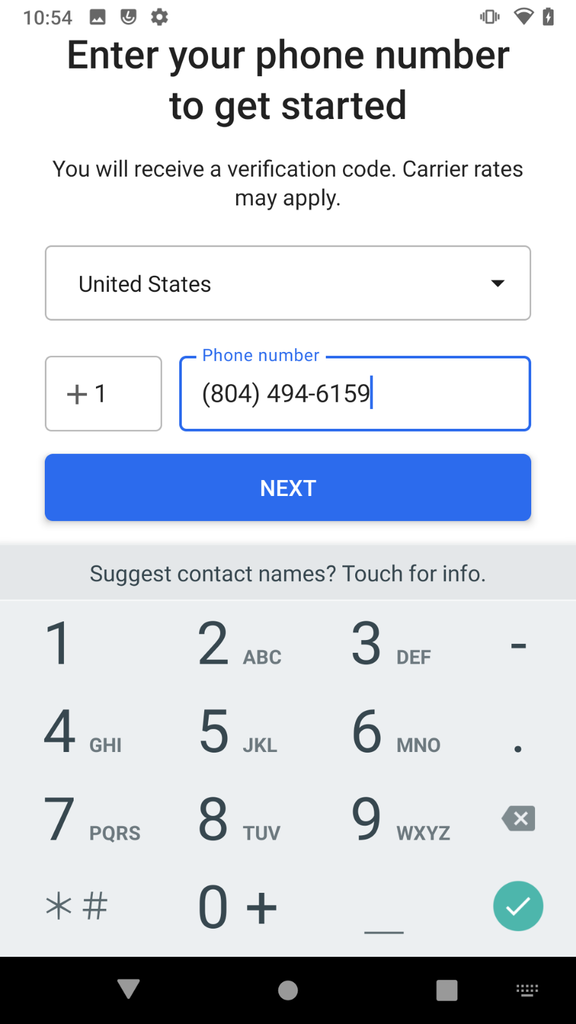
In order to verify your phone number, you will be sent an SMS text with a six-digit code. You will now be prompted to enter that code.
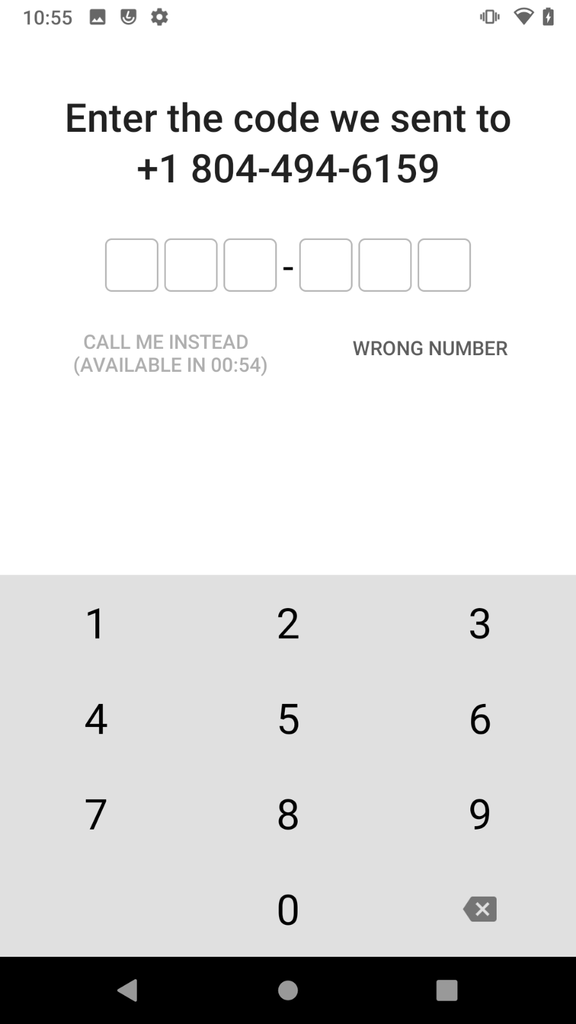
Step 4: Choose a Profile Name and Image
The profile image and name you choose will be shown to any contacts you have saved in your address book, when you initiate or accept new chats, and when you join new groups. A first name (either genuine or made up) is required, the image and last name are optional. Enter your information in this step and tap “Next.”
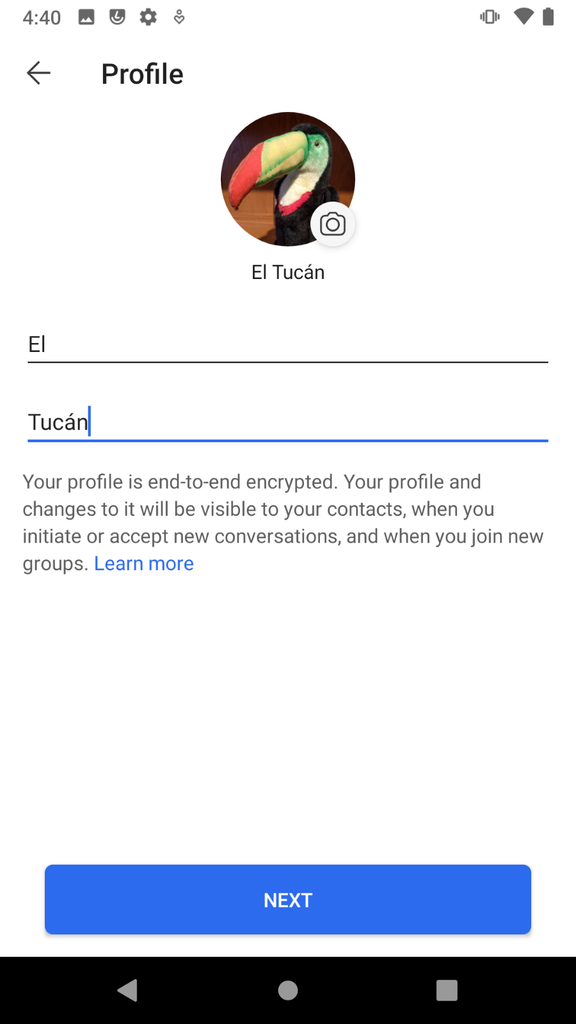
Step 5: Choose a PIN or Passphrase
A PIN keeps your information safe on Signal’s servers, and if you switch phones you will be able to recover your settings, profile, and contacts using it. Choose a secure PIN or Passphrase and then tap “Next.”
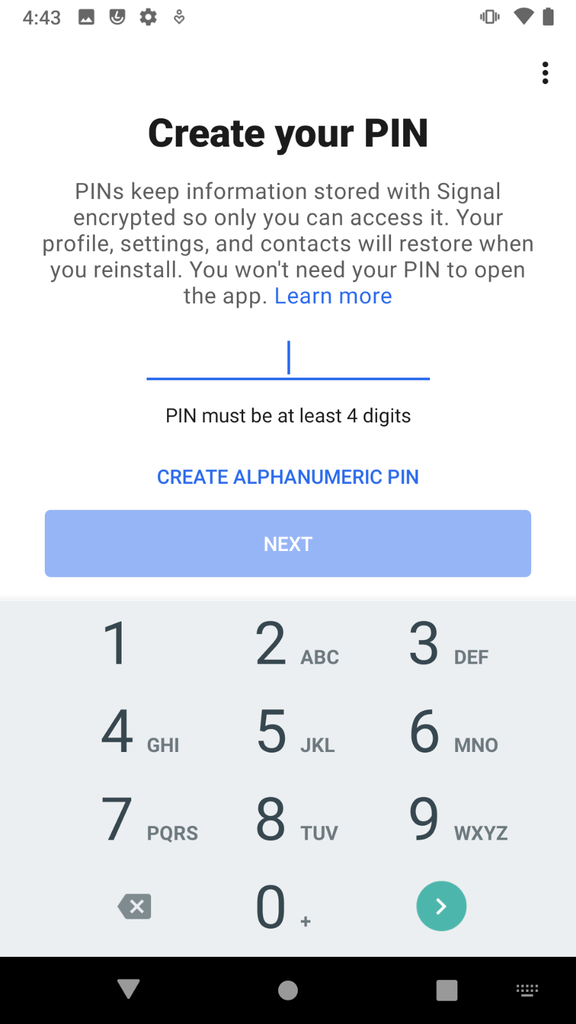
You will be asked to confirm your pin. Enter it again and tap “Next.”
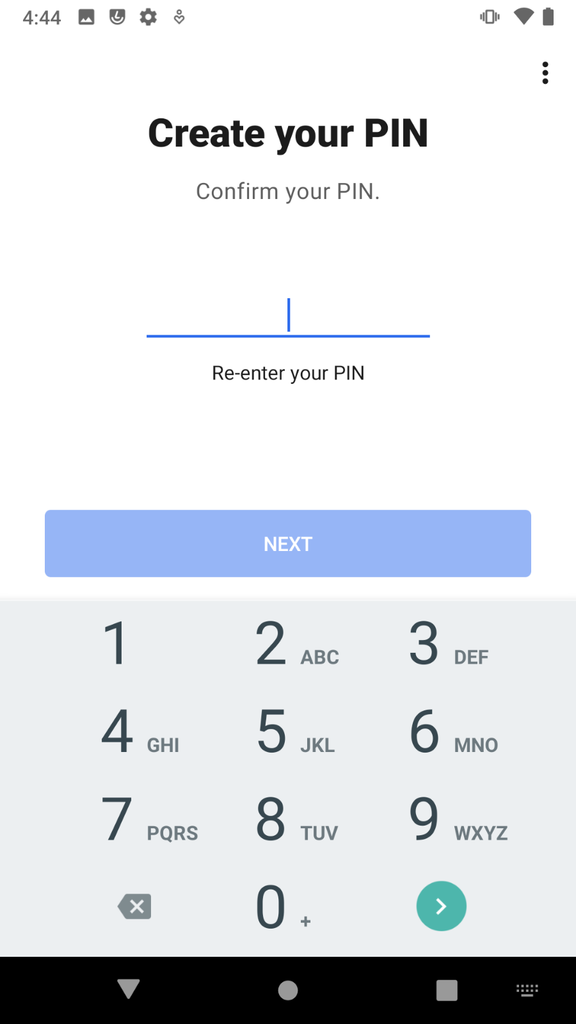
Using Signal
In order to use Signal, the person that you are contacting must have Signal installed. If you try to send a message to someone using Signal and they do not have the Signal app installed, it will attempt to send a standard, non-encrypted text message. The standard text message will only be sent if Signal set as the default SMS app. If you try to call the person, it will place a standard phone call.
Warning: Signal provides you with a list of other Signal users in your contacts. To do this, data representing the phone numbers in your contact list is uploaded to the Signal servers, although this data is deleted almost immediately. This may be an issue for those with particularly sensitive threat models. If sharing your contacts with Signal is a concern, you can deny the contacts permission during setup as described above.
Communicating with a Contact
How to Send an Encrypted Message
Warning: Note that the Signal Foundation, the makers of Signal, use other companies’ infrastructure to send its users alerts that they’ve received a new message. They use Google on Android and Apple on iPhone. That means information about who is receiving messages and when they were received may leak to these companies.
To get started, tap the pen icon in the center-right of the screen.
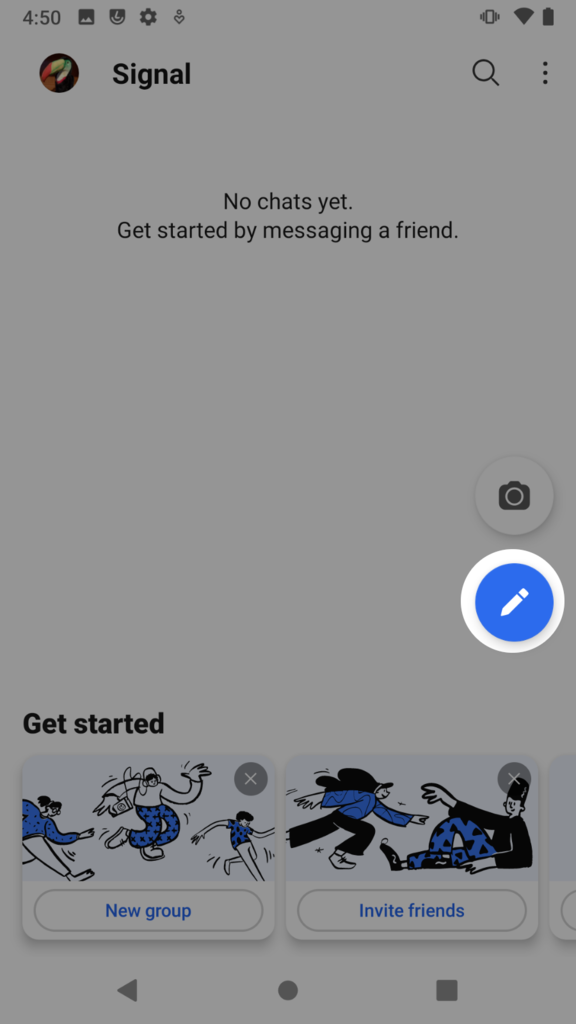
You will see a list of all the registered Signal users in your contacts.
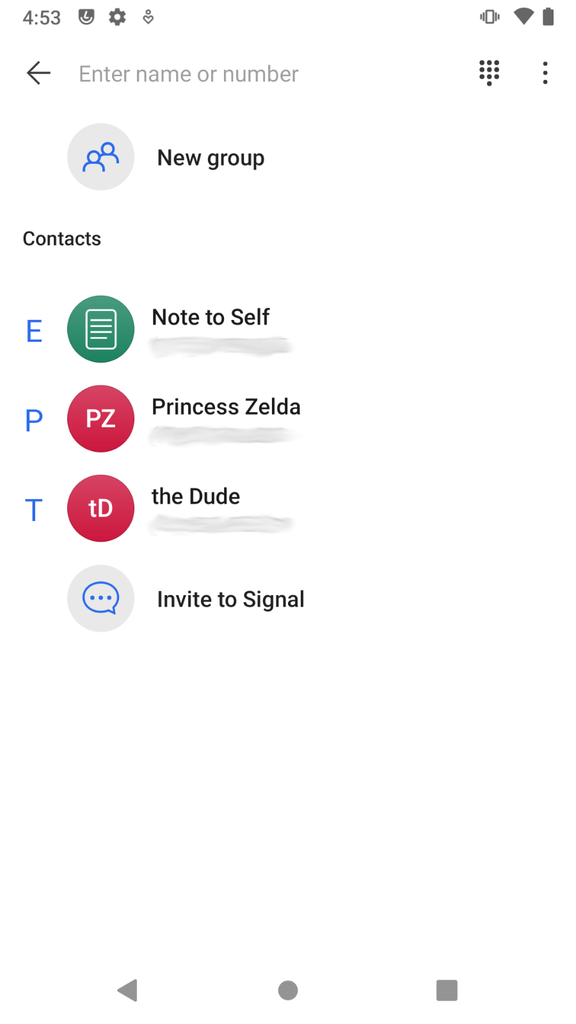
When you tap a contact, you’ll be brought to the conversation screen for your contact. From this screen, you can send end-to-end encrypted text, picture, stickers, audio, or video messages.
How to Initiate an Encrypted Call
To initiate an encrypted video call to a contact, select that contact and then tap on the camera icon (1). For voice calls, tap on the phone icon (2).
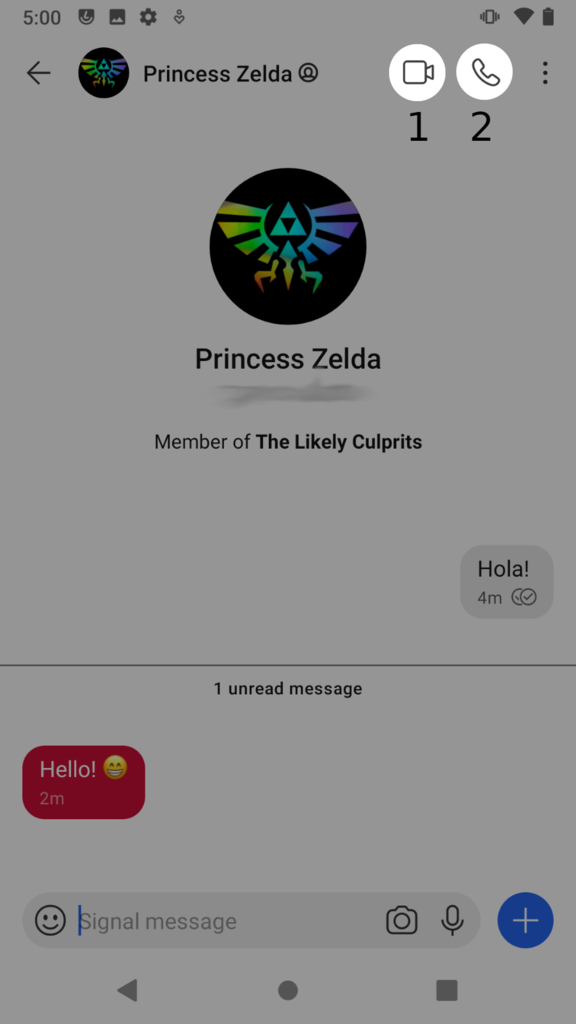
At this point, Signal may ask for permission to access the microphone. Tap “Allow.”
Once a call is established, your call is encrypted.

Communicating with a Group
How to Start an Encrypted Group Chat
You can send an encrypted group message by tapping the pen icon in the center-right of the screen, and then selecting “New Group.”

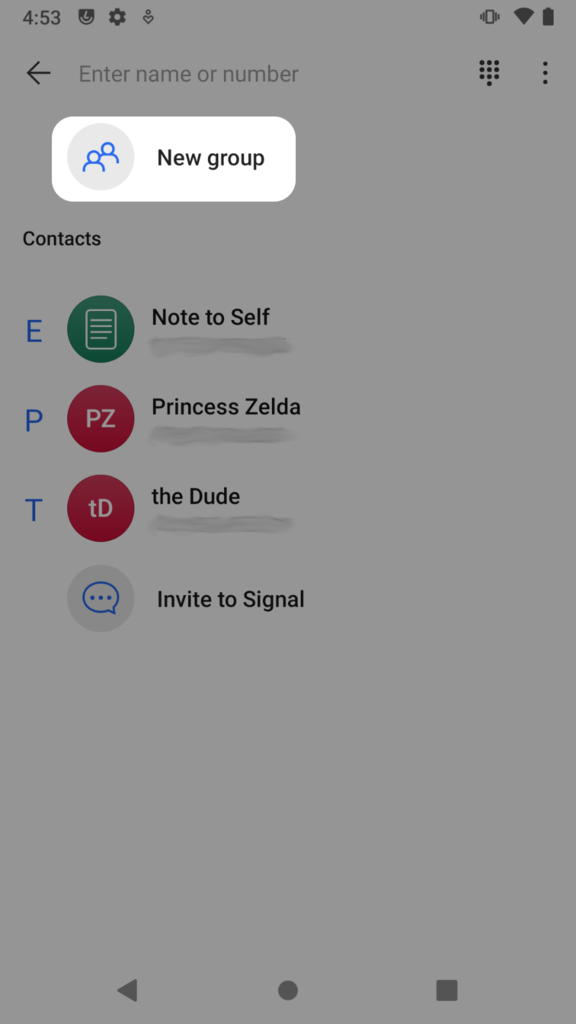
On the following screen, you’ll be able to add participants to the group. After adding participants, you can tap the arrow in the lower right corner of the screen.
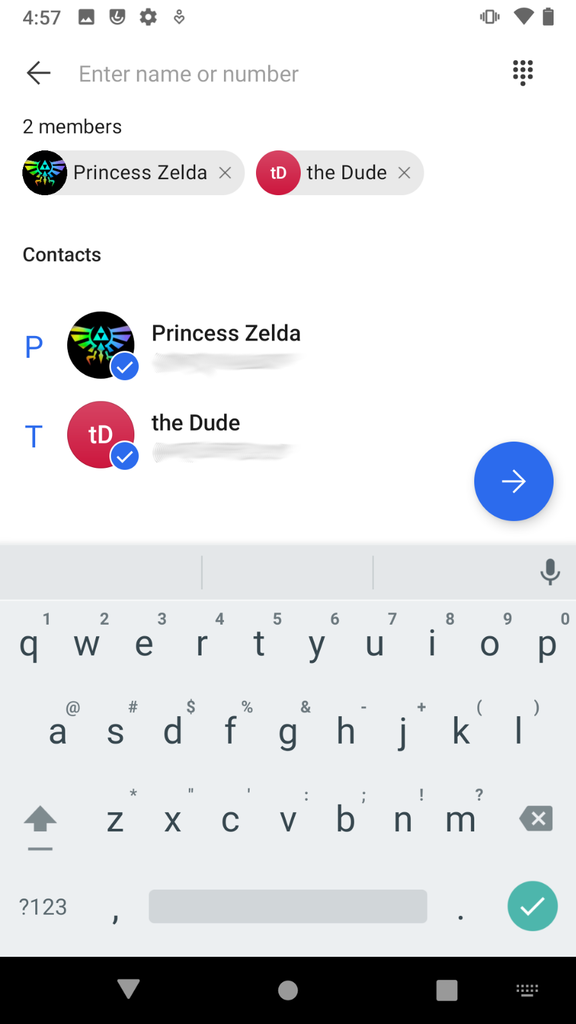
You can now name the group, then tap “CREATE.”
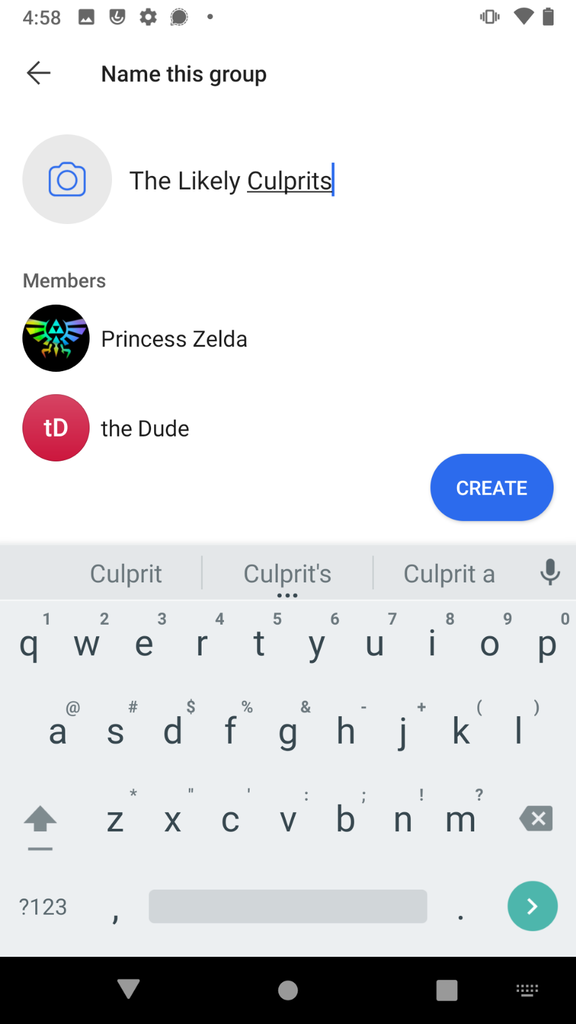
This will initiate the group chat.
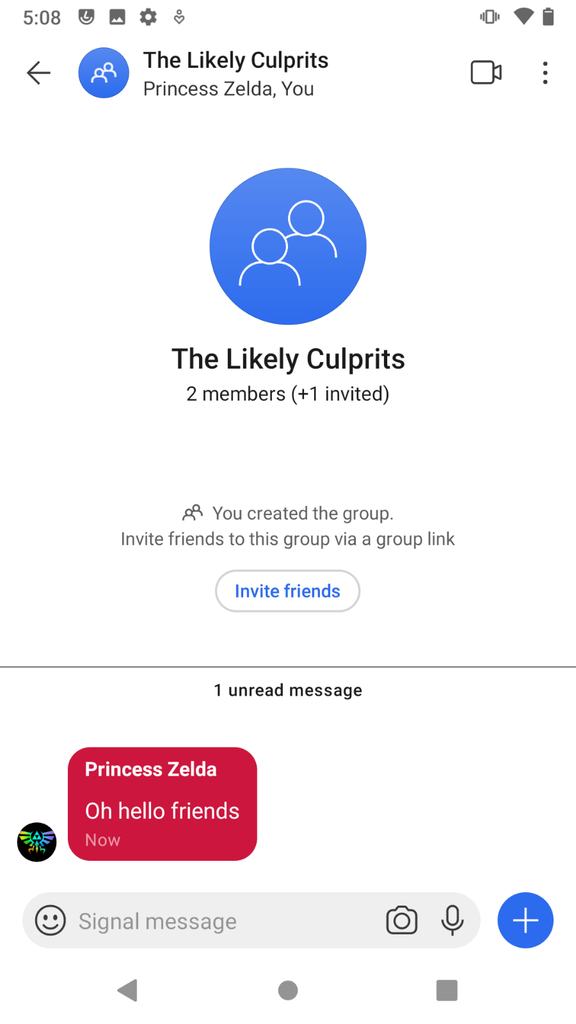
At this point, anyone can add members to the group. If you wish to change this, or the group name, icon, or add or remove participants, this can be done from the group chat screen by tapping the name of the group.
Sharing a Link for Anyone to Join Your Group
Signal allows you to create a link for a group and share that link so anyone can join without having to be added manually.
To enable the “group link”, open the screen where you are able to message your group. From this screen, tap the name of the group at the top of the screen, then scroll down and tap on “Group link.”
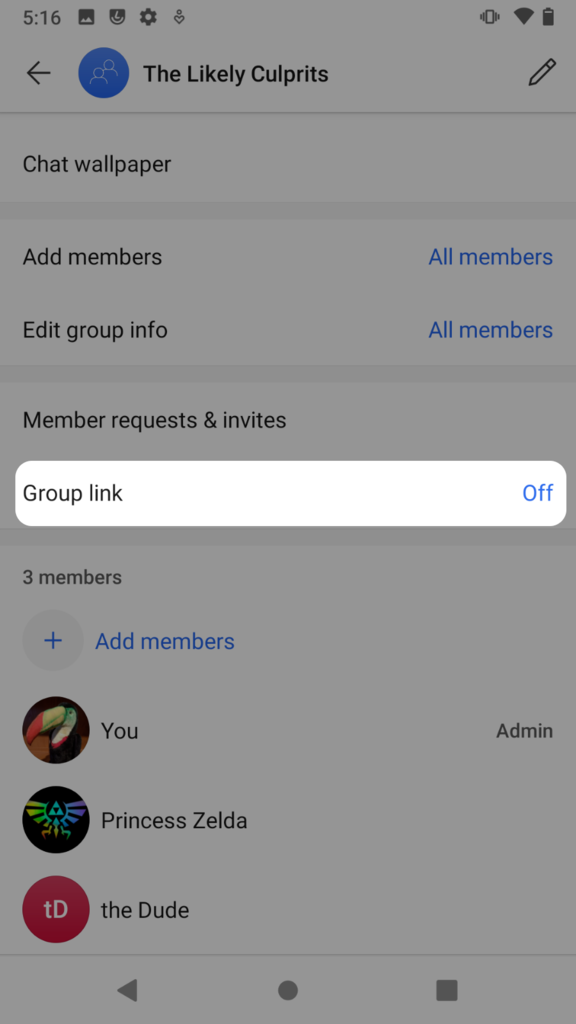
A screen will appear allowing you to enable the group link, and also choose whether new members must be manually approved by a group administrator. In this example, we enable both of these.
Once enabled, you can share the group link with others by tapping “Share.”
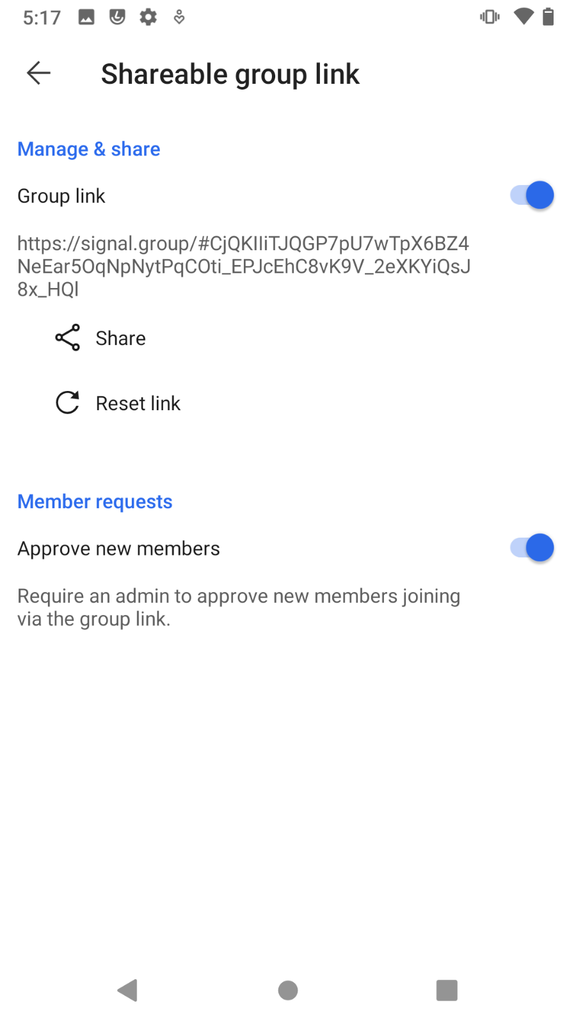
If you’ve enabled “Approve New Members,” any time a member tries to join the group you will receive a notification as seen below.
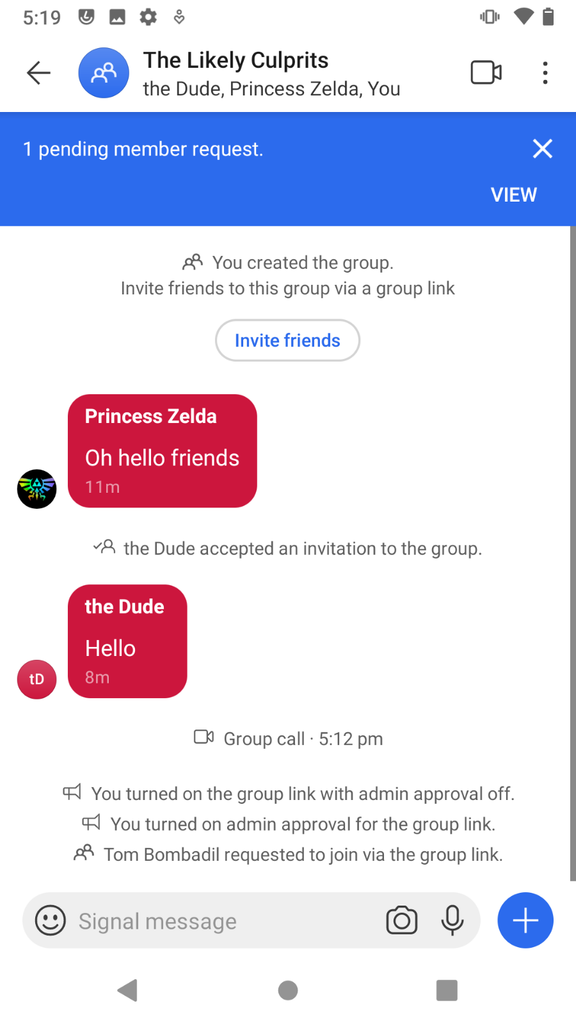
From here, you can tap “VIEW” to be brought to the “Pending group invites” screen. You can also navigate to this screen from the group settings screen.
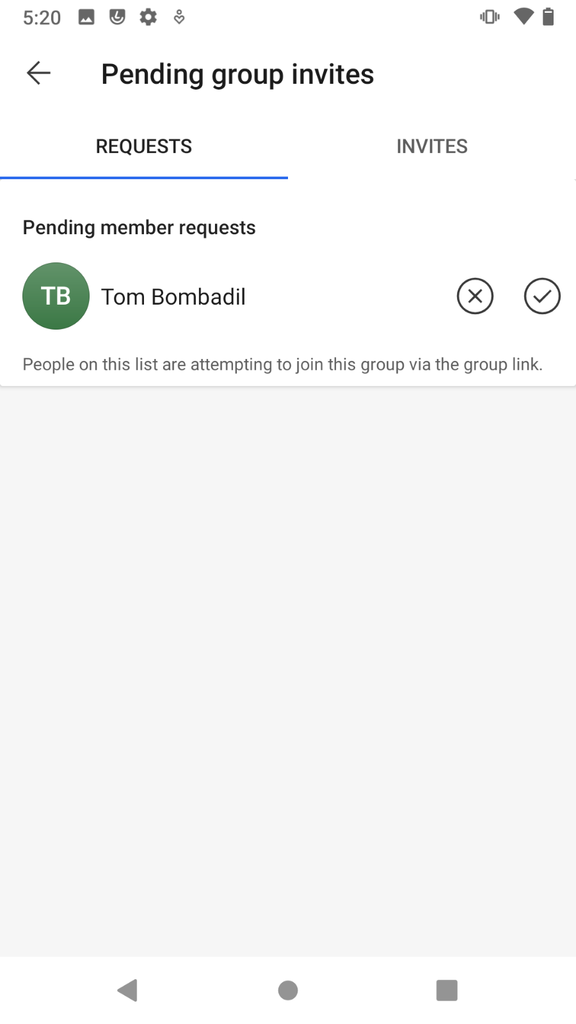
Tap the check mark to approve a request, or the “x” to deny it.
Restricting and Administering Groups
When first created, anyone can add new members to a group or change group settings. Groups can be restricted so that only group administrators have these permissions.
To restrict a group, open the screen where you are able to message your group. From this screen, tap the name of the group at the top of the screen, then scroll down. You will see the group settings under “Add members” and “Edit group info.” Tap on these to change the settings.
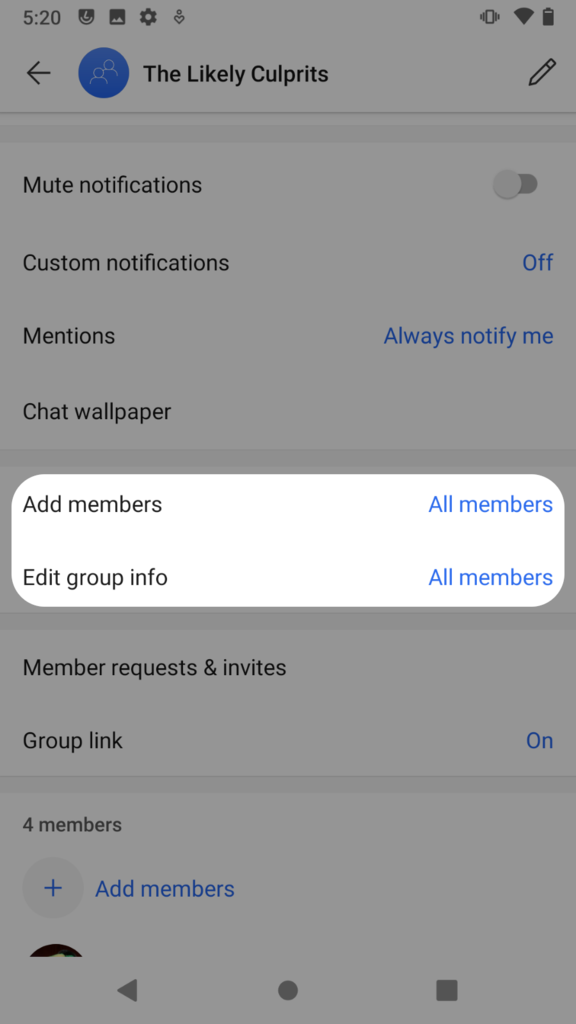
When a group is first created, the only administrator is the group creator. Signal allows the group creator to delegate administrator permissions to members of the group.
To make a member an administrator, tap on the group name at the top of the screen. Then, scroll all the way down to group members. Tap on a member.
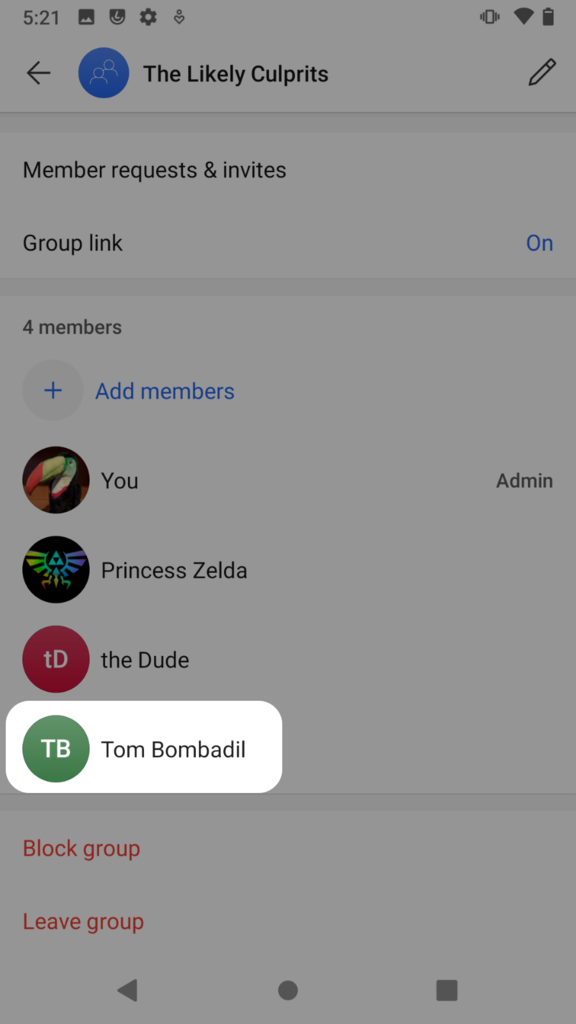
You will see the option to make that member an administrator of the group.
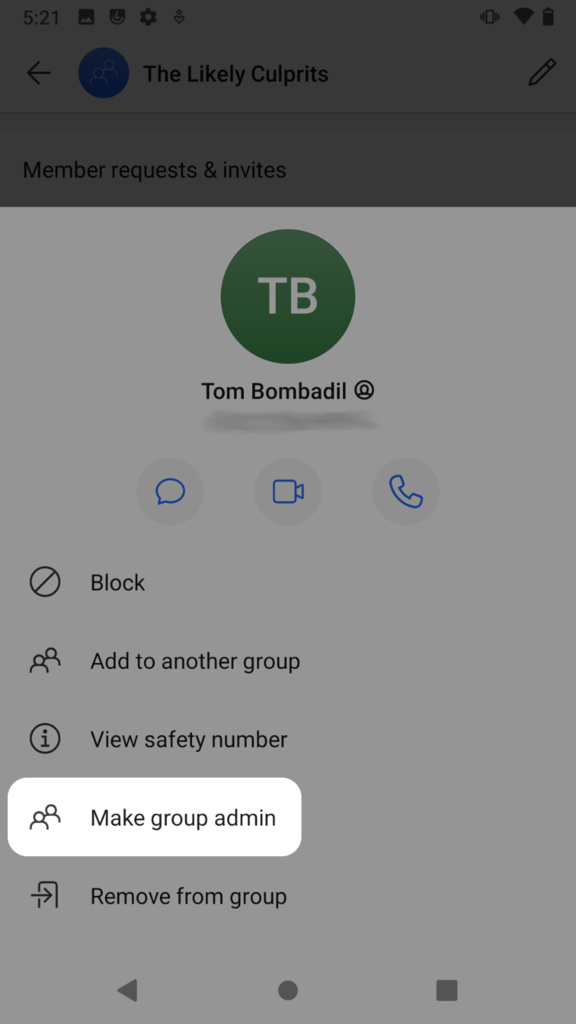
How to Initiate a Group Encrypted Call
To initiate an encrypted video call to an entire group, select that group and then tap on the camera icon.
![]()
At this point, Signal may ask for permission to record audio. Tap “Allow.”
You will then see a screen with the ability to swap which camera you are using, turn off video, or mute your microphone before initiating the call. Tap “Start Call.
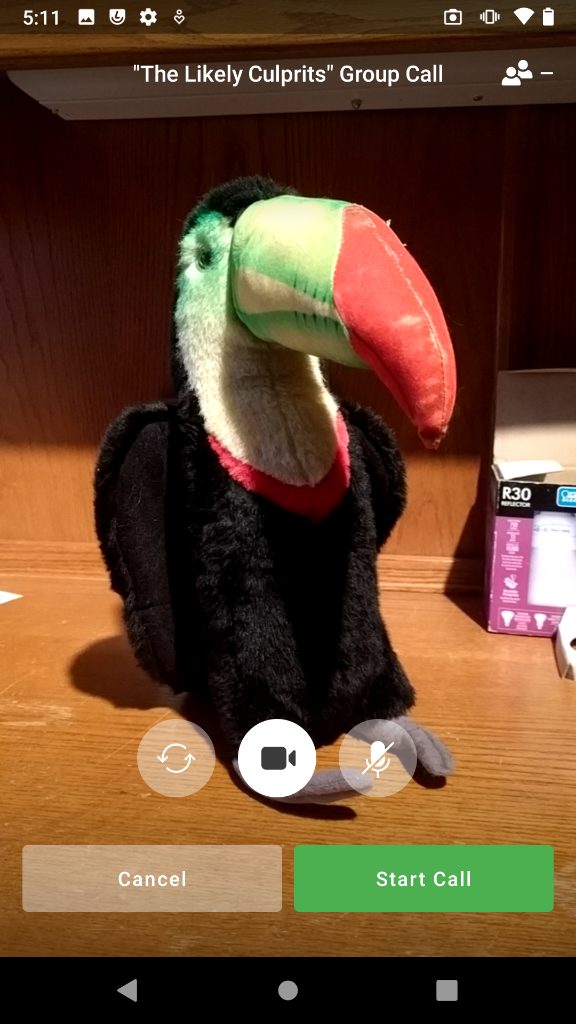
At this point, your call will start. When participants join your call, they will display on your screen.

Mute Conversations
Sometimes conversations can be distracting. One feature that is especially useful for group chats is muting notifications so you don’t see a new notification every time a new message is written. This can be done from the group chat screen by tapping the group name and selecting “Mute.” You can then select how long you’d like the mute to be active for. This can be applied to individual conversations as well, if desired.
How to Verify your Contacts
At this point, you can verify the authenticity of the person you are talking with. This is to ensure that their encryption key wasn’t tampered with or replaced with the key of someone else—a process called key verification . Key tampering is a potential risk when downloading an application over an insecure network. Verifying is a process that takes place when you are physically in the presence of the person you are talking with.
First, open the screen where you are able to message your contact, as described above. From this screen, tap the name of your contact at the top of the screen.
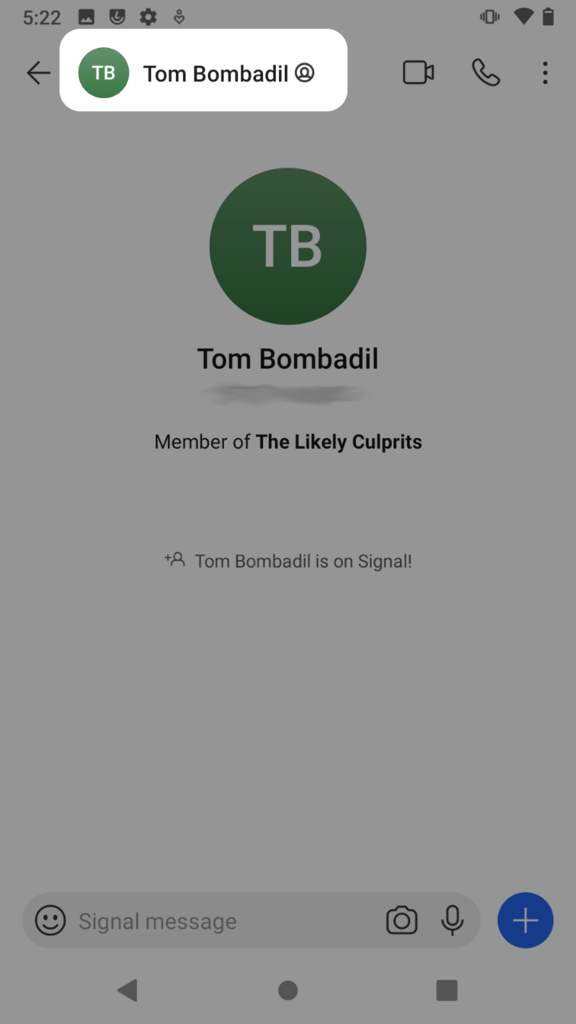
From the following screen, tap “View safety number.”
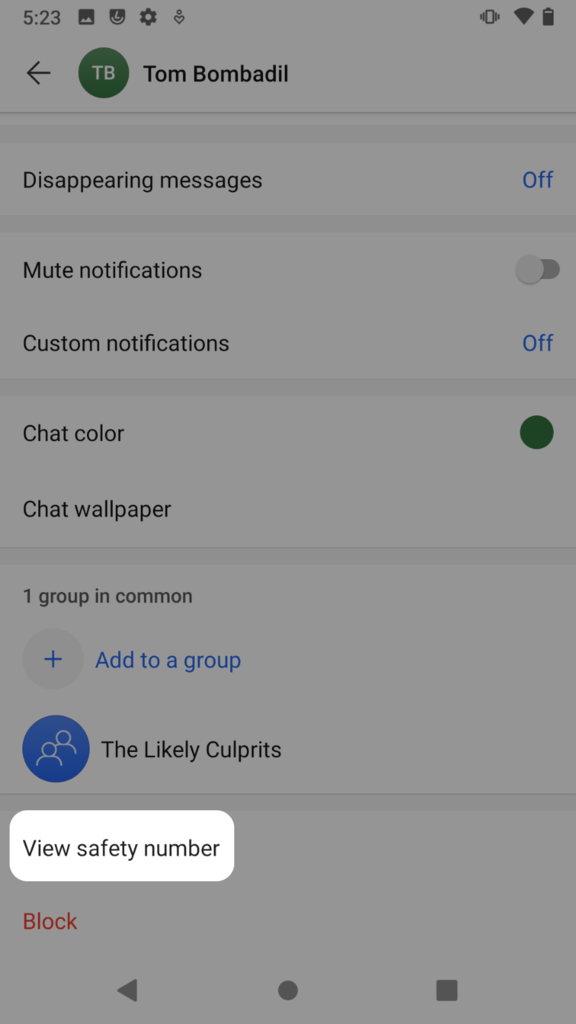
You will now be brought to a screen which displays a QR code and a ‘safety number.’ This code will be unique for every different contact you are conversing with. Have your contact navigate to the corresponding screen for their conversation with you, so that they have a QR code displayed on their screen as well.
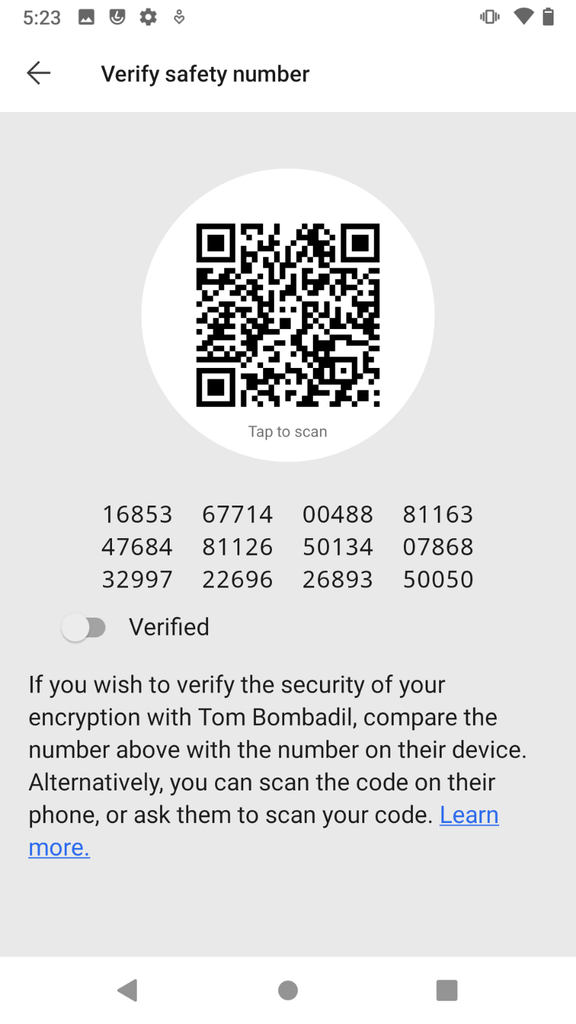
Back on your device, tap the QR code to scan. At this point, Signal may ask for permission to access the camera. Tap “Allow.”
Now you will be able to use the camera to scan the QR code that is displayed on your contact’s screen. Align your camera to the QR code:
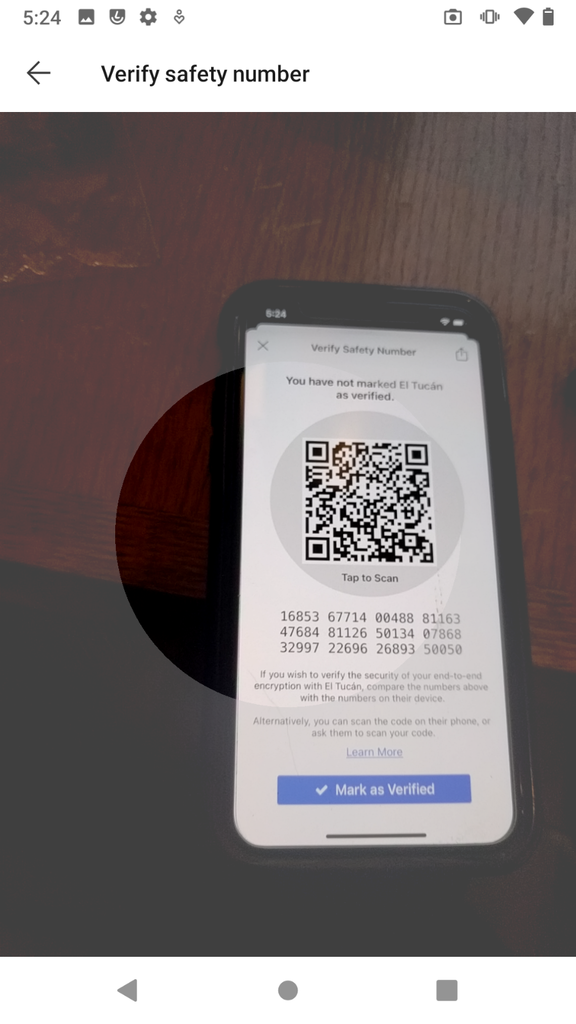
Hopefully, your camera will scan the QR code and show a green check mark, like this:
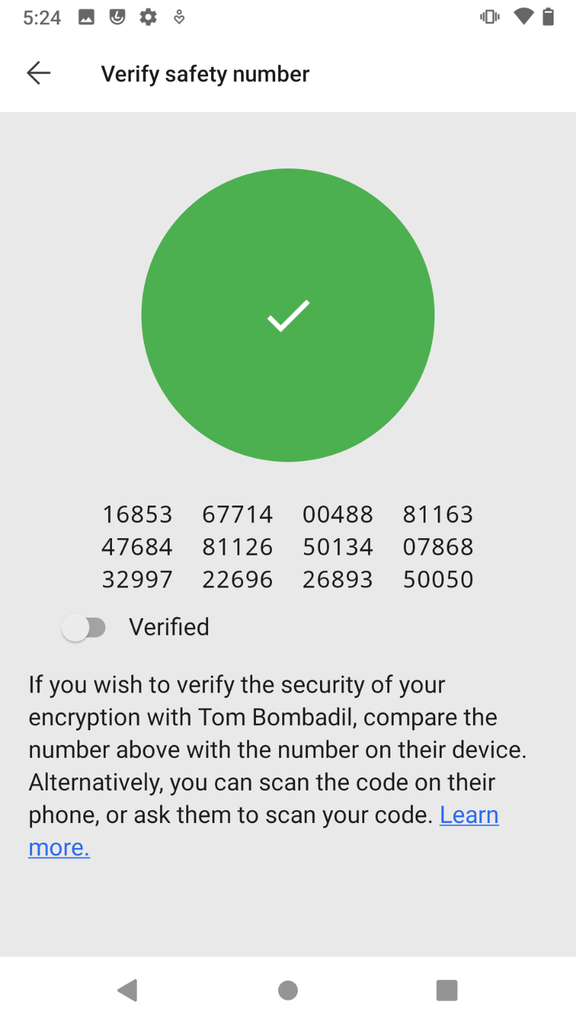
This indicates that you have verified your contact successfully. You should now move the “Verified” slider to the right to have the app remember that your contact has been verified. If instead your screen looks like this, something has gone wrong:
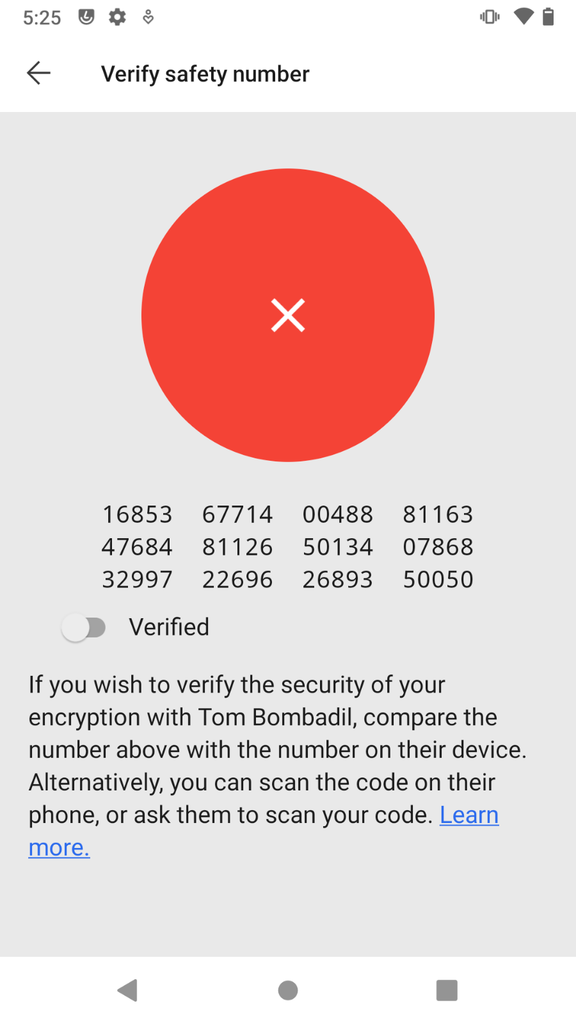
You may want to avoid discussing sensitive topics until you have verified keys with that person.
Note for power users: The screen displaying your QR code also has an icon to share your safety number in the top-right corner. In-person verification is the preferred method, but you may have already authenticated your contact using another secure application. Since you’ve already verified your contact, you can safely use the trust established in that application to verify numbers within Signal, without having to be physically in the presence of your contact. In this case you can share your safety number with that application by tapping the “share” icon and sending your contact your safety number.
Disappearing Messages
Signal has a feature called “disappearing messages” which ensures that messages will be removed from your device and the device of your contact(s) in a chat some chosen amount of time after the messages are seen.
Warning: You do not have control over the person with whom you are chatting—she could be logging or taking screenshots of your conversation, even if you’ve enabled “disappearing messages.”
To enable “disappearing messages” for a conversation, open the screen where you are able to message your contact or group. From this screen, tap the name of the contact or group at the top of the screen, then tap “Disappearing messages.”
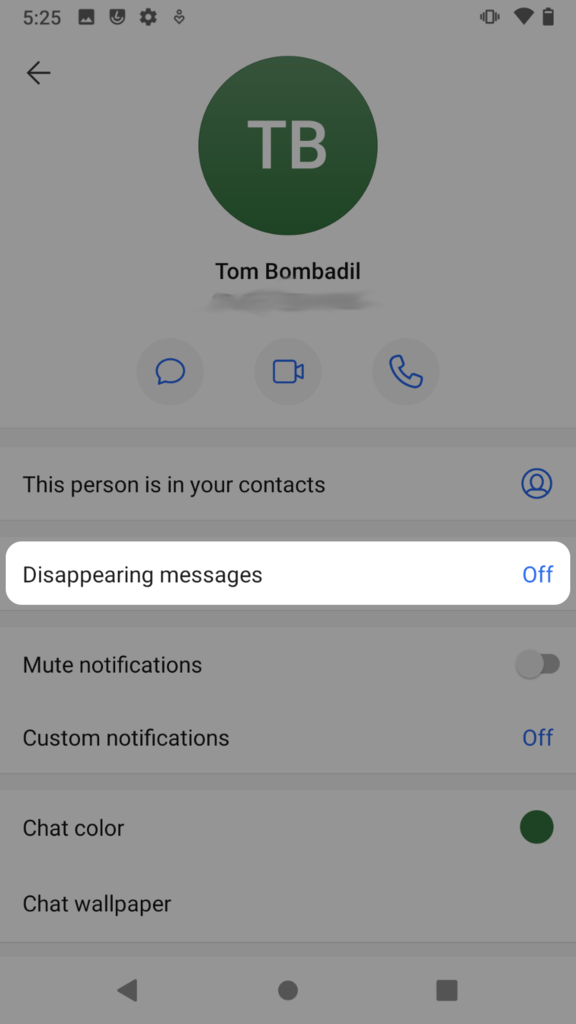
A dialogue will appear that allows you to choose how quickly messages will disappear:
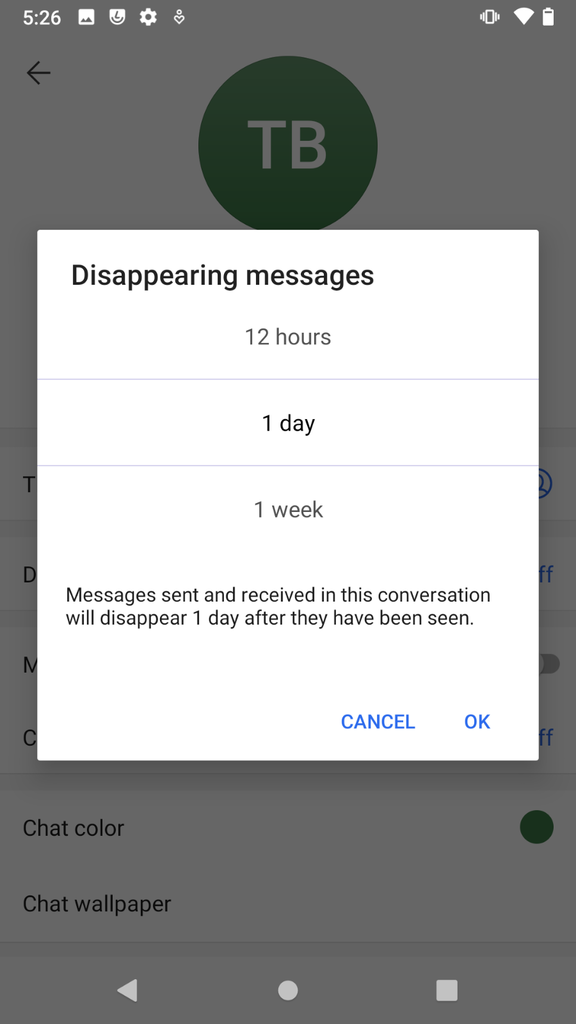
After selecting this option, tap “OK,” and then tap the “←” on the top-left corner of the screen, and you should see information in the conversation indicating that “disappearing messages” have been enabled.
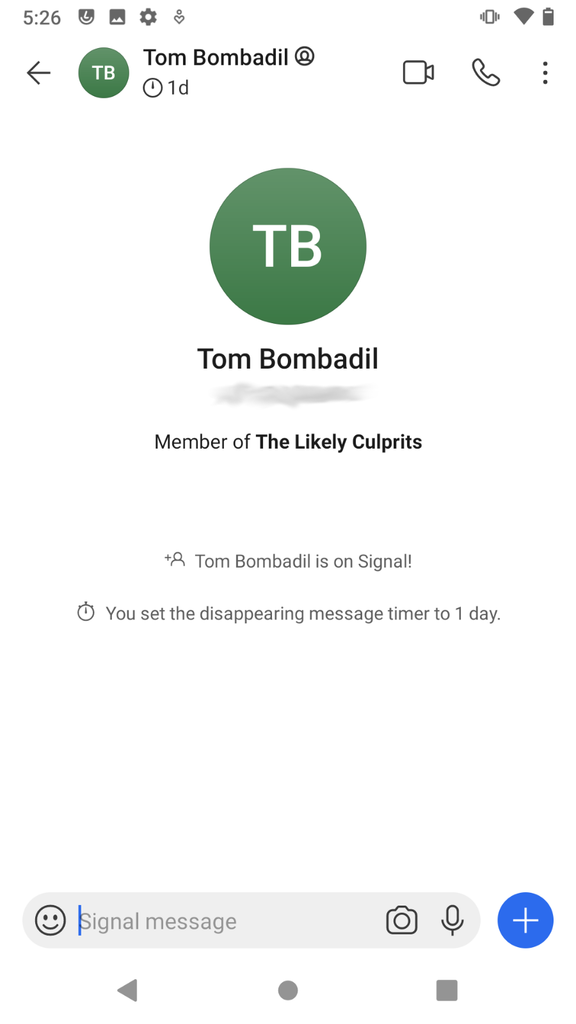
You can now send messages with the assurance that they will be removed after the chosen amount of time.
Sending Files or Photos
Signal also enables you to share files and photos with your contacts. From the conversation screen, tap the “+” icon in the bottom-right corner of the screen.
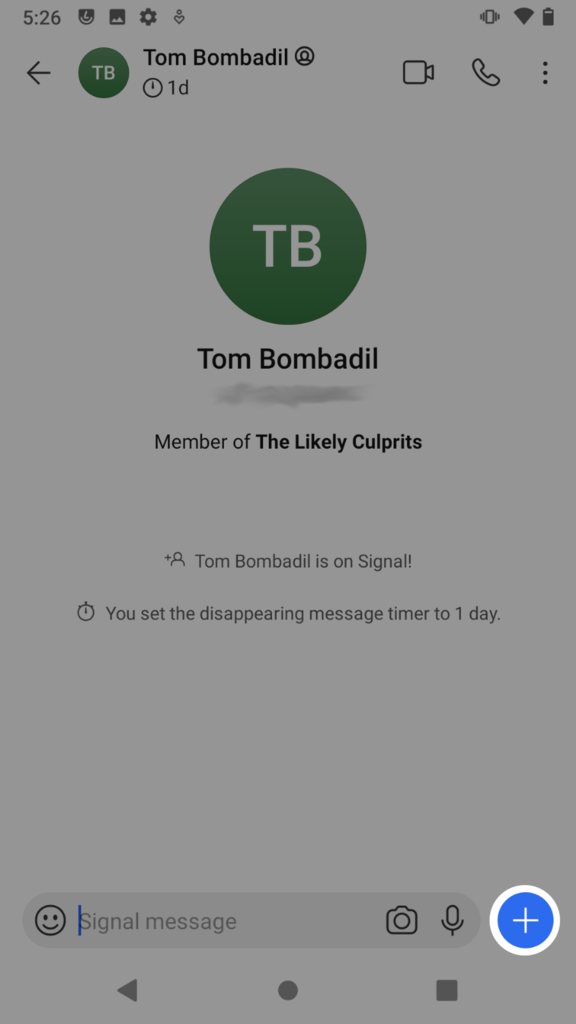
At this point, Signal may ask for permission to your photos. Tap “GIVE ACCESS” and then “Allow” in the subsequent dialogue.
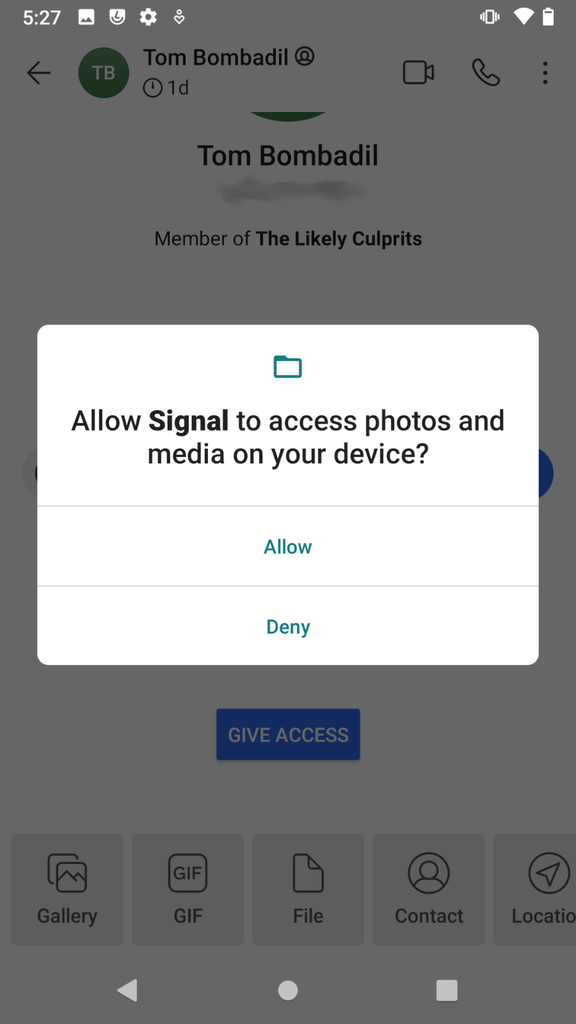
The bottom of the screen will now display a marquee of photos which you can select to share. Below that, you can also choose to share a file, contact, or your location.
